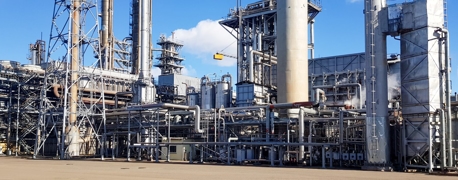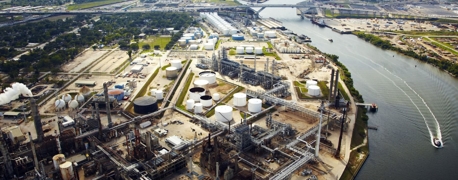5 Explosions & The Small Devices That Could Have Prevented Them

Anyone who’s worked with machinery knows that the smallest pieces can cause the biggest problems. An invisible leak, a steady accumulation of gas or dust, a broken gasket—any one of these small things can have enormous consequences for a commuter car or residential heating system. Imagine how much worse the consequences are for a plant, factory, or oil rig.
Unfortunately, we don’t have to imagine too hard; these workplaces have seen their share of massive disasters or fatal events. What’s shocking is how many of these accidents began with small, often inexpensive pieces of equipment (or, in one case, a slip of paper). Today’s article is about those small, neglected parts that might have helped avert the worst industrial disasters in the U.S. and beyond.
#1: The Ocean Ranger Oil Rig Disaster, 1982 – A Metal Window Cover
The Ocean Ranger was the largest semi-submersible oil platform of its time, lauded as “unsinkable” by its builders and admirers. The platform was supported by two enormous hulls with ballast tanks that would fill up or drain to raise or lower the platform. The tanks in each hull were controlled by a ballast control room that sat 28 feet above the water, underneath the rest of the platform. This control room would empty or fill the tanks with sea water, which controlled the height of the platform.
In February 1982, the rig was warned by NORDCO that a severe storm was coming to the shore of Newfoundland. Procedure demanded that the Ocean Ranger de-ballast, allowing it to sit higher above the waves. However, key members of the crew were not trained to use the ballast control system, so the de-ballasting never happened. This left the control room dangerously close to the roiling waters of the storm.
During the storm, a massive rogue wave struck the ballast control room. It’s important to note that the control room had two windows, or “portlights,” to give an unobstructed view of the hulls. Attached to the portlights were “deadlights,” or enormous metal storm covers meant to protect the windows in an event just like the one the rig was facing. There was no standing order to use the deadlights, which meant the rogue wave was able to strike the glass directly, shattering it and allowing water to flow freely into the ballast control room.
The result was catastrophic. Water caused ballast controls to malfunction, which opened valves in the hull at random. With its hulls imbalanced, the ship began to list, making it impossible for the pumps to empty the ballast tanks. This eventually caused the entire rig to capsize, leading to the death of all 84 crew members.
If the storm covers had been dropped to protect the portlights, it’s unlikely that the rogue wave could have destroyed the portlights, and the Ocean Ranger might have stayed afloat. On one of the most technically sophisticated oil rigs in existence at the time, it was the lack of a small metal window cover that sealed its fate.
#2: The Piper Alpha Explosion & Fire, 1988 – A Slip of Paper
At 14,000 tons, the Piper Alpha oil rig was one of the largest platforms in the world. It was also the most profitable and productive in the world, with a higher output than any rig in production. In 1988, it was undergoing routine semi-annual maintenance on its condensate pumps, which helped prepare product for delivery to shore. The entire platform relied on two condensate pumps: Pump A and Pump B. During the day shift, the engineer took Pump A offline, replacing its safety valve with a hand-tightened metal disc called a “blind flange” so that it was disconnected from the rest of the rig. He wrote a permit instructing the night shift to leave Pump A offline and to, under no circumstances, turn it on.
He also intended to discuss Pump A with the on-duty custodian, who was monitoring the control room that night. However, because the custodian was busy, he left the permit where the custodian would find it: in the control room.
This permit has never been found.
Later that night, the custodian got an alarm that triggered the automatic shutoff of Pump B. That’s not a disaster on its own, but because the custodian never got notified about Pump A, he brought it back online. Flammable gas flowed out of the pump which, without a safety valve, immediately leaked into the surrounding air. The gas eventually finds an ignition source and explodes, killing some workers instantly. The resulting fire lasted for two hours before the Piper Alpha sank into the ocean.
In the end, 165 rig crew and 2 rescue workers lost their lives—all due to a missing piece of paper.
#3: The Deepwater Horizon Explosion, 2010 – Dead 27-Volt Battery
Drilling for oil on the seabed comes with unique and dangerous challenges, chief of which is handling the incredible pressure of the ocean floor. As the drill bores into the ground, highly pressurized pockets of gas, water, and oil can sometimes shut up through the borehead, sending it all the way up to the rig at high speeds in what’s called a “kick.” Oil rigs have blowout preventer systems, or BOPs, to ensure this highly pressurized and flammable material stays beneath the surface.
The BOP of the Deepwater Horizon had three different failsafes to prevent a kick, with two redundant systems to ensure the final failsafe worked properly. Yet, despite all that, the Deepwater Horizon’s blowout preventer failed in April 2010. How?
One of the first lines of defense for the blowout preventer is a pipe ram that clamps down crude oil and gas within the borehead. The second line of defense is a rubber-sealed valve that shuts off the upward flow of crude oil, gas, and debris. On the day of the explosion, massive pressure sent mud flowing toward the rig. The BOP system seemed to engage the rubber seal, but it didn’t block the flow all the way. This allowed crude oil to continue traveling upward—the first failure of the BOP.
However, not even this should have spelled disaster. In the event of an emergency, the final line of defense for an oil rig is a blind shear ram designed to cut and seal the pipe to stop the flow of oil. The blind shear ram on the Deepwater Horizon had two independent operators attached to it. However, there were three critical failures that prevented the blind shear ram from working as designed:
- The backup 27-volt battery for one operator was completely drained, which prevented the operator from engaging the blind shear ram.
- The solenoid valve for the second operator was miswired, which paralyzed the blind shear ram.
- The pipe within the BOP was bent due to severe differences in pressure caused by the kick, which meant the pipe was out of reach of the blind shear ram’s blades.
These critical failures meant that the blind shear ram crushed, but did not seal, the pipe—which allowed crude oil to continue passing through the valve.
In other words, a poorly wired valve and a failed 27-volt battery were collectively responsible for one of the worst disasters in oil drilling history. The Deepwater Horizon explosion resulted in 11 deaths and 17 severe injuries, as well as significant harm to over 100 others.
#4: Carbide Industries Electric Arc Furnace Explosion, 2011 – Ceramic Liner
Electric arc furnaces, or EAFs, can reach temperatures of 3800 degrees Fahrenheit, which makes them ideal for creating molten products out of high-melting point material. Carbide Industries in Louisville, KY employed an electric arc furnace five stories tall designed to create calcium carbide products. The furnace tank sat at the bottom of the five-story structure and had both a ceramic liner and a refractory liner to prevent the heat from melting the tank. These liners also contained water lines to help keep the tank cool.
However, in 2011, workers at Carbide Industries started having trouble managing the EAF’s pressure. Excess pressure would cause material and debris to shoot out of the tank, exposing workers to life-threatening burns. Workers speculated that the pressure issues were caused by water from the cooling system leaking into the tanks.
On March 21, 2011, the EAF tank experienced catastrophic pressurization. Workers in a nearby control room watched the tank rise in temperature and explosiveness from behind a double-paned window designed to protect them from the heat and potential debris. However, the force of the pressure in the tank sent debris flying far harder and faster than normal, shattering the glass.
As a result, the two workers in the control room died from burn injuries. Two others were seriously injured.
Upon investigation, the Chemical Safety Board determined that the most likely cause was the wearing down of the ceramic or refractory lining in the tank’s lid. The thinning liner would have eventually formed holes that allowed water to enter the tank, creating pressure that caused the temperature to rise. Had Carbide Industries repaired the tank or lid when the pressure issues first arose, those workers would likely be alive today.
#5: Williams Olefins Geismar Explosion, 2013 – $5 Car Seal
In 2001, the Williams Olefins facility in Geismar, LA updated its facility to have two independent reboiler tanks to heat propane into a distillation column. The idea was to create a system where one tank could always be operational while the other tank underwent maintenance. Since the tanks accumulated oily tar in their water lines every few years (a process known as “fouling”), keeping one tank online while the other was cleaned meant the plant wouldn’t need to shut down every few years. Each tank was fitted with propane valves and water valves.
However, the upgrade project was poorly documented, so engineers missed a fatal flaw created by the new valves: if the water valves were ever opened on the standby tank while the propane valves remained closed, the heated propane would pressurize without access to a safety valve, turning the 24-foot long tank into a bomb.
Eventually, an engineer discovered the flaw, but management did nothing to solve it. The fix would have taken very little effort; all they needed to do was add a $5 car seal to the standby tank's water valves to keep them closed until the propane valves could be safely opened. The seal would ensure any maintenance workers would keep propane flow connected to the safety valve in the distillation column until the tank’s full shutdown.
Tragically, the car seal was never installed.
On June 13, 2013, one of the tanks was taken offline due to fouling. The standby tank (Reboiler B) was brought online by opening its water valves, but the engineer in charge didn't realize it was 65% full of propane. Like other engineers predicted might happen, the water valves remained open while the propane valves were closed. Water continually heated the trapped propane, giving it nowhere to go. In less than five minutes, the tank exploded.
The resulting explosion and fire killed 2 workers—one at the scene and another the next day. Over 100 more were injured by the fire or in the evacuation. Our firm represented over a dozen of these workers against Williams Olefins and its parent company, proving to juries in two separate trials that the company could have prevented untold harm with just a $5 car seal.
It’s difficult to ask ourselves what might have been. But sometimes, in cases where people’s lives were threatened or lost, it’s necessary to ask what could have been done differently. So many lives are at the mercy of the smallest things; that’s why it’s vital for manufacturing and industrial companies to invest as much as possible into safety and inspection.
Otherwise, it’ll be the small things that cost us everything.
- Categories


